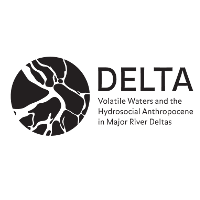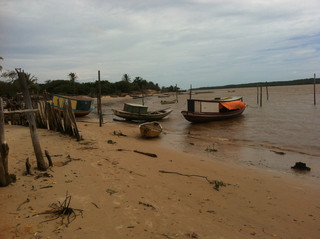“Here is the beginning and end of the delta”, a fisherman told me proudly. He was standing at the bank of the Parnaíba River, fishing with a handline. First I was struck by his words and I was wondering whether I got the right sense. Only after talking with him for a while I started to understand the meaning of his words.
In the following weeks several other inhabitants of the deltaic region, expressed similar understandings of where the delta actually started. In Pedra do Sal situated on the Ilha Grande, inhabitants repeatedly told me that the delta was “over there”, pointing westwards with their hands. They all referred to the islands, especially the Ilha das Canárias, which lay on the west shore of the Parnaíba River.
These boundaries that people pointed out do not match with the geographic boundaries of the delta. In fact, as Szczygielski et al. (2014) point out, geographically speaking, the delta extends east and westwards of the Parnaíba River. The eastern part belongs to the state of Piauí, and consists of an actively migrating coastal dune field, enclosed by the Parnaíba river mouth in the west and the smaller Igaraçu River, the last distributary of the Parnaíba river, on the south-east. The western part is dominated by tidal channels that drain a large mangrove area.
The inhabitants’ remarks point to invisible boundaries within the deltaic area and by this reflect ways in which the delta is appropriated and differently taken into plans and projects for the future. In fact, the contexts and dynamics of Pedra do Sal and Canárias, despite of their proximity, differ in various aspects.
Pedra do Sal is a village of about 100 houses, situated on the coastal part of the Ilha Grande de Santa Isabel, which belongs to the State of Piauí. However, it is not part of the municipality of Ilha Grande, but of Parnaíba. Defined as rural area of Parnaíba which otherwise is rather urbanized, it plays in fact an important role by being the only beach of this municipality.
Currently, the state as well as the municipality are investing in several projects in Pedra do Sal, including the urbanization of the seafront. Governor Wellington Dias stated that they were working on a plan, that aims to win a series of investments including large foreign investors (CidadeVerde, 2016). One of them is Pure Resorts that is planning to construct in Pedra do Sal the first luxury resort at the coast of Piauí. It will feature an eco-friendly five-star hotel and residential area. The area of 160 hectares at the seaside will consist of about 150 units including bungalows and apartments. Pure Resorts emphasise that it will be the first five-star resort for visitors of the world-famous Parnaíba Delta. Located at only 8km from the “delta mouth”, it is according to them the ideal base to explore the delta islands, “dense mangroves”, “impressive sand dunes” and “freshwater ponds” as well as numerous animal species (www.pureresorts.com).
As found in other tourism marketings, once again, the delta is described in terms of a “natural paradise”. Such a vision of the delta, does not fit to the Ilha Grande, which is much more densely populated than the other islands. Obviously, it neither fits in the investment and urbanization plans for Pedra do Sal, which already started with the widening of the road leading to Parnaíba. Pedra do Sal, thus, turns into an entry point for the delta, located in this perspective westwards – a perspective, that is appropriated by several inhabitants.
The fisherman who indicated to me the starting and ending point of the delta, lives in a village called Canárias on an island with the same name, which is part of the state of Maranhão.
Canárias is composed of around 200 houses and together with four other villages is located in a conservation unit called “Marine Extractive Reserve” (RESEX Marinha), established in 2000. Mattos (2006) points out that the RESEX is the fruit of negotiations between conservation projects and the local population’s necessity to resolve problems related to land property rights. In fact, it is today forbidden to sell land or houses to foreigners and thus a protection against large investors. The RESEX emerged as new solution for people to have guaranteed the right to stay on their lands and in exchange they guarantee the government to use resources sustainably.
As a protected area, Canárias is an attractive destination for tourism excursions. They preferably use the waterways to get around the delta as the island is made of sandy ground and thus makes transport more difficult. A number of these excursions start and end near Canárias at the shore of the Parnaíba River – the same shore where the fisherman was standing. His remarks about the beginning and ending of the delta thus referred to these flows of tourists on the waterways of the delta.
In both examples what is striking is the elaboration of the delta in relation to tourism. The term “delta” then is external to expressions of belonging of the inhabitants and rather used in a specific way for tourism marketing and then appropriated by inhabitants.
References
Mattos, F. F. (2006). Reservas Morais: estudo do modo de vida de uma comunidade na Reserva Extrativista Marinha do Delta do Parnaíba. Tesis (Mestrado em ciências socais em desenvolvimento, agricultura e Sociedade–CPDA/UFRRJ)
Szczygielski, A. et al. (2014). Evolution of the Parnaíba Delta (NE Brazil) during the late Holocene. Geo-Marine Letters, 35.2, pp. 105-117.
Cidade Verde, 2016. Pedra do Sal ganha infraestrutura e impulsiona turismo e empreendimentos estrangeiros. Retrieved from http://cidadeverde.com/noticias/226116/pedra-do-sal-ganha-infraestrutura-e-impulsiona-turismo-e-empreendimentos-estrangeiros
Pure Resorts Parnaíba. See http://www.pureresorts.com/pt/, accessed 04.04.2017

